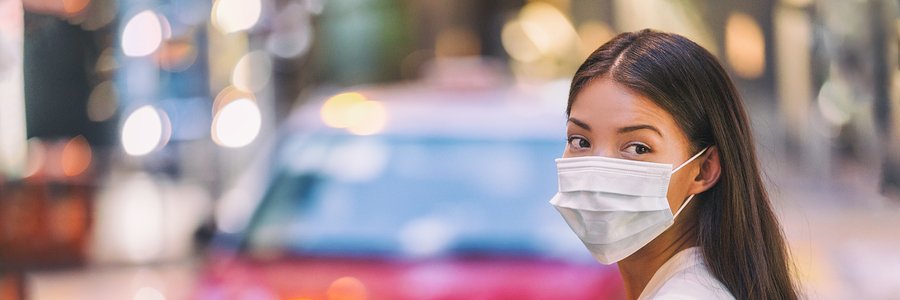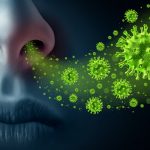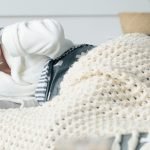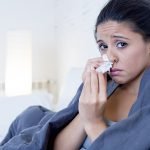Article Summary:
- Wearing a face mask protects you from inhaling allergens and shields against spreading and contracting flu and other infectious diseases.
- However, respirators offer better protection than masks since face masks don’t seal and therefore allow tiny airborne particles to reach the face near the nose and mouth.
- But to truly protect yourself, you need more than just a mask: you need to be prepared on all fronts.
How Face Masks Prevent Colds and Flu
Walk down a typical city street and you’ll see plenty to gawk at—old ladies with pink hair, fifth-graders with nose rings, and people of all ages wearing spooky white face masks. Unlike the pink hair and nose jewelry, the white surgical masks are not a fashion statement. Once worn only by medical professionals in surgical settings, these days you might see people wearing them in airports, in malls, at concerts, or at PTA meetings. The trend started when the SARS epidemic hit in Asia in 2003. At that time, the use of face masks in public became common in Asian countries, and slowly, the West has followed suit—although the numbers in Asia are still far higher.1Phend, Crystal. “Unmasking the Surgical Mask: Does it Really Work?” 5 October 2009. MedPage Today. 22 March 2019. http://www.medpagetoday.com/infectiousdisease/infectioncontrol/16278 In any case, it’s reached the point where many health clinics dispense surgical masks to all who enter.
Wearing a face mask purportedly helps in two ways. First, you get to keep your own germs to yourself. And second, you get to keep everybody else’s germs away from you. In other words, masks protect you from inhaling allergens and otherwise work as a shield against spreading and contracting flu and other infectious diseases. So, should you run to the drug store and buy a pack of 100 to protect yourself from all the sniffling people around you?
Types of Face Masks for Flu Prevention
First, you should know that there are several types of mask available. The masks distributed to the public at clinics usually appear as white, non-woven paper-like sheaths that cover the mouth and nose and are fastened to the head by elastic bands or ties. These masks are typically pleated, and though they vary in thickness, they’re often made of three layers, including a middle moisture-resistant barrier layer of polypropylene or something similar.2Lipp, Allyson. “The effectiveness of surgical face masks: What the literature shows.” 30 September 2003. Nursing Times. 22 March 2019. http://www.nursingtimes.net/clinical-archive/infection-control/the-effectiveness-of-surgical-face-masks-what-the-literature-shows/205272.article They’re meant to be disposable and worn only once. If they get wet, they become useless and should be thrown away.
You also can buy masks treated with antiviral substances. For instance, Curad sells a mask it claims kills “99.99% of tested flu viruses in 5 minutes of contact on the surface of the facemask.”3http://www.amazon.com/Curad-Antiviral-Face-Mask-Count/dp/B009GGUIK6/ref=sr_1_13?hvadid=241927863553&hvdev=c&hvlocphy=1021157&hvnetw=g&hvpos=1t2&hvqmt=e&hvrand=16096534150713901085&hvtargid=aud-646675773986%3Akwd-96706175&keywords=surgical%2Bmask&qid=1553284173&s=gateway&sr=8-13&tag=googhydr-20&th=1 Although the box says the masks are intended for use in “medical settings only,” they’re easily purchased by consumers via the internet. The antivirals embedded in the Curad masks include “trace amounts of t3 powerful [nutritionally supportive] yet safe ingredients – citric acid, copper and zinc, all of which are toxic to harmful pathogens and perfectly safe for humans.” Of course, breathing in too much copper can be dangerous in spite of Curad’s claims, and in fact, evidence suggests that too much copper can lead to psychiatric problems, liver dysfunction, and autoimmune disorders.4curad antiviral face mask The trace amounts in Curad’s surgical masks may not pose any problem, but continuous use of these masks probably wouldn’t be wise.
If the bizarre look of surgical masks makes you reluctant to wear one out on the streets, know that you can buy fancy masks with cute designs. Flyusa, for instance, sells variety packs sporting cartoon characters.5http://www.amazon.com/Flyusa-Colorful-Spunlace-Disposable-Surgical/dp/B0779QNSCD/ref=asc_df_B0779QNSCD/?tag=hyprod-20&linkCode=df0&hvadid=312039468639&hvpos=1o2&hvnetw=g&hvrand=14306371685187522164&hvpone=&hvptwo=&hvqmt=&hvdev=c&hvdvcmdl=&hvlocint=&hvlocphy=1021157&hvtargid=pla-569343289882&psc=1 Breathe Healthy makes washable masks decorated with pawprints, flames, or zebra stripes—in case you think having pawprints or flames covering your mouth would make you look less spooky.6http://www.breathehealthy.com/shop/colorful-paws-mask/?gclid=Cj0KCQjwj9LkBRDnARIsAGQ-hUfaSADskIXVZj4mT8NbhOrCyC17lsJ3auDGLC4TiFkYWVVD-m8_EekaAr23EALw_wcB
Respirators For Flu Prevention
Then, there are respirators, a step up from face masks. Respirators seal tightly around the nose and mouth, unlike the looser-fitting masks, which means they typically have a concave shape and look even goofier than masks. They likely filter out smaller particles than surgical masks do, and again, they fit closer to the face. The US standard is the N95 respirator, which is certified to block 95 percent of particles as small as 0.3 μm (millionths of a meter), which is about the same size as a single virus. (During the California wildfires, these masks became hot-selling items since they filter out airborne particulates carried via smoke.) Like surgical masks, respirators are quite affordable ($8-$30) and easy to find at pharmacies or hardware stores.
It should be noted that there are several ways pathogens can reach the respiratory system.7Coia, John E. et al. “Use of respiratory and facial protection.” 17 January 2014. Nursing Times. 23 March 2019. http://www.nursingtimes.net/clinical-archive/infection-control/use-of-respiratory-and-facial-protection/5067167.article?search=https%3a%2f%2fwww.nursingtimes.net%2fsearcharticles%3fqsearch%3d1%26keywords%3dsurgical+masks First, if a sick person coughs or sneezes they may expel “splashes,” which are large particles (greater than 100 μm in diameter) that drop to the ground fast. Masks usually can protect against these. Droplets are a smaller version of splashes, between 5 μm and 100 μm. Then there are small, lightweight aerosol particles of less than 5 μm that remain suspended in the air, travel over distance, and easily penetrate the respiratory system. Aerosol particles can come from sneezes, coughs, or just exhalations of the sick person. In fact, the air around an infected person is usually loaded with aerosol particles containing viruses or bacteria. Since aerosol particles can travel and linger in the air, experts recommend that you stay at least six feet away from contagious people.
Theoretically, respirators offer better protection than masks since face masks don’t seal and therefore allow tiny airborne particles to reach the face near the nose and mouth. And yet, a 2009 Canadian study of 446 nurses who were working with influenza patients concluded that face masks provided protection almost equivalent to that provided by respirators.8Loeb, M., et al. “Surgical mask vs N95 respirator for preventing influenza among health care workers: a randomized trial.” 4 November 2009. JAMA. 23 March 2019. http://www.ncbi.nlm.nih.gov/pubmed/19797474 Unfortunately, that turns out to be mixed news. Of the nurses wearing surgical face masks, 23.6 percent contracted the flu, versus 22.9 percent of those wearing N95 respirators. Ironically, that same year, an Australian study of 2000 Chinese healthcare workers had quite different results. According to the report from that study, “Consistent use of N95 respirators prevented 75% of respiratory infections (about the same as the Canadian study), while consistent surgical mask use was no better than low use for prevention of clinical respiratory illness (6.7% versus 9.2%, P=0.159) or of influenza-like illness (0.6% versus 1.3%, P=0.336).” In other words, surgical masks were nearly useless in preventing infection, but respirators were highly effective.
While masks can’t guarantee those exposed to sickness won’t get ill, another Australian study concluded that wearing a mask at home when someone in the house is sick can reduce the likelihood of infection by 60 to 80 percent.9Klasco, Richard, MD. “Do Face Masks Really Keep You Healthy?” 23 March 2018. New York Times. 23 March 2019. http://www.nytimes.com/2018/03/23/well/live/face-masks-work-healthy-colds-flu-immunity-prevention.html The key is to wear the mask all the time. Even more effective, perhaps, is getting the sickie to wear a mask. Scientists found that when an ill person keeps a surgical mask on, they exhale 25 times fewer droplets. Again, though, the mask does not prevent exhalation of aerosol particles. For that, you need a respirator. And, as Dr. Mark Rupp, former president of the Society for Healthcare Epidemiology of America, says, “[Respirators] are relatively difficult to breathe through; they can be associated also with feelings of claustrophobia and kind of a suffocating sensation. It’s difficult enough to get [patients] to wear a loose fitting and relatively comfortable surgical mask.”
The bottom line is that if someone whom you live or work with is sick, you’ll reap a small bit of protection wearing a mask and more wearing a respirator, provided you keep it on. If you can convince the patient to mask up, better yet. But to truly protect yourself, you need more than just a mask: you need to be prepared on all fronts. In addition to the mask, try to stay six feet away from the infected person, eat well, get enough sleep, and take both an immune building formula and a natural anti-pathogenic formula.
References
| ↑1 | Phend, Crystal. “Unmasking the Surgical Mask: Does it Really Work?” 5 October 2009. MedPage Today. 22 March 2019. http://www.medpagetoday.com/infectiousdisease/infectioncontrol/16278 |
|---|---|
| ↑2 | Lipp, Allyson. “The effectiveness of surgical face masks: What the literature shows.” 30 September 2003. Nursing Times. 22 March 2019. http://www.nursingtimes.net/clinical-archive/infection-control/the-effectiveness-of-surgical-face-masks-what-the-literature-shows/205272.article |
| ↑3 | http://www.amazon.com/Curad-Antiviral-Face-Mask-Count/dp/B009GGUIK6/ref=sr_1_13?hvadid=241927863553&hvdev=c&hvlocphy=1021157&hvnetw=g&hvpos=1t2&hvqmt=e&hvrand=16096534150713901085&hvtargid=aud-646675773986%3Akwd-96706175&keywords=surgical%2Bmask&qid=1553284173&s=gateway&sr=8-13&tag=googhydr-20&th=1 |
| ↑4 | curad antiviral face mask |
| ↑5 | http://www.amazon.com/Flyusa-Colorful-Spunlace-Disposable-Surgical/dp/B0779QNSCD/ref=asc_df_B0779QNSCD/?tag=hyprod-20&linkCode=df0&hvadid=312039468639&hvpos=1o2&hvnetw=g&hvrand=14306371685187522164&hvpone=&hvptwo=&hvqmt=&hvdev=c&hvdvcmdl=&hvlocint=&hvlocphy=1021157&hvtargid=pla-569343289882&psc=1 |
| ↑6 | http://www.breathehealthy.com/shop/colorful-paws-mask/?gclid=Cj0KCQjwj9LkBRDnARIsAGQ-hUfaSADskIXVZj4mT8NbhOrCyC17lsJ3auDGLC4TiFkYWVVD-m8_EekaAr23EALw_wcB |
| ↑7 | Coia, John E. et al. “Use of respiratory and facial protection.” 17 January 2014. Nursing Times. 23 March 2019. http://www.nursingtimes.net/clinical-archive/infection-control/use-of-respiratory-and-facial-protection/5067167.article?search=https%3a%2f%2fwww.nursingtimes.net%2fsearcharticles%3fqsearch%3d1%26keywords%3dsurgical+masks |
| ↑8 | Loeb, M., et al. “Surgical mask vs N95 respirator for preventing influenza among health care workers: a randomized trial.” 4 November 2009. JAMA. 23 March 2019. http://www.ncbi.nlm.nih.gov/pubmed/19797474 |
| ↑9 | Klasco, Richard, MD. “Do Face Masks Really Keep You Healthy?” 23 March 2018. New York Times. 23 March 2019. http://www.nytimes.com/2018/03/23/well/live/face-masks-work-healthy-colds-flu-immunity-prevention.html |










